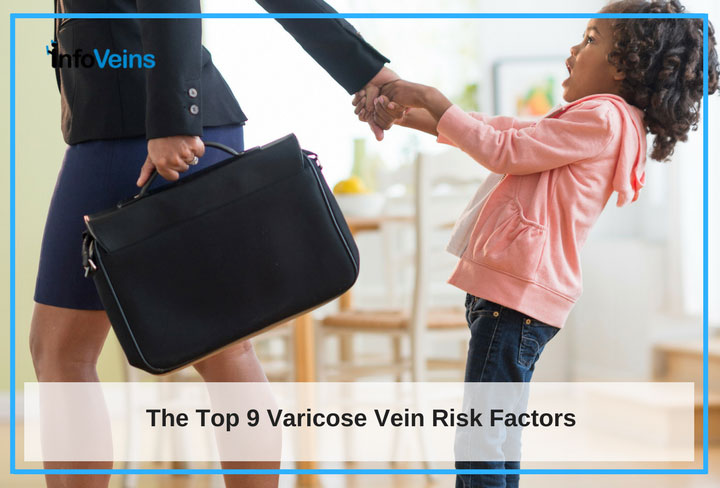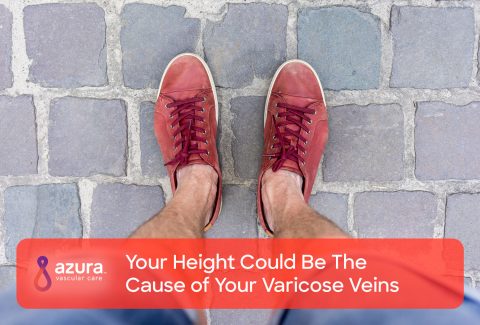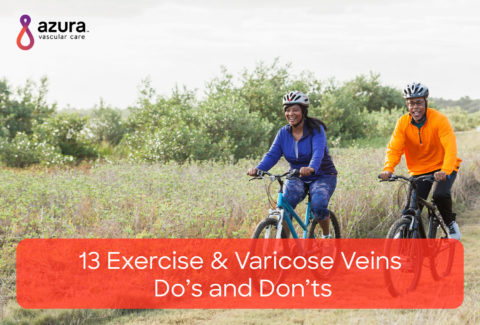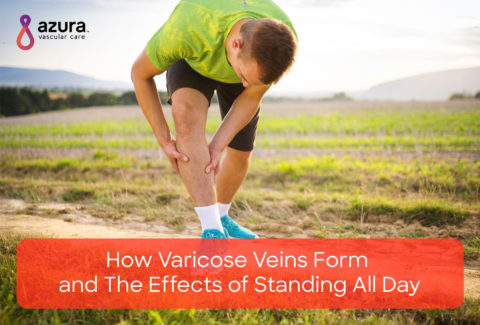
If you’ve been diagnosed with, or you think you may have, varicose veins, you’re not alone. In fact, these dilated bulging bluish-purple veins that can be seen and often felt under the surface of the skin are present in up to 30% of people. i We know they’re common…but who gets varicose veins? Are you at risk?
While it’s true that varicose veins can happen to anyone, there are certain risk factors that increase your chances of developing them. Keep in mind that while some of these factors can be addressed through lifestyle changes, others are out of your control.
What Causes Varicose Veins?
Having a clear understanding about what causes varicose veins may help you to better understand the risk factors for varicose veins.
Veins carry the unoxygenated blood from the body back to the heart. One-way valves are present in veins to prevent blood from flowing backward. When these valves are not working properly, blood pools, pressure within the veins increases straining the walls of the veins. Weak vein walls can also play a part in the stretching of varicose veins. These stretched veins can be seen and felt just under the surface of the skin.
Varicose veins should not be confused with spider veins, which are a smaller version of varicose veins made up of red or blue lines that look like a web or a branch. While spider veins usually do not have any physical symptoms, larger varicose veins have symptoms and can lead to more serious health conditions.
Are you wondering if you’re at risk for varicose veins? Let’s look at the top 9 risk factors for varicose veins.
9 Varicose Vein Risk Factors that You Should Be Aware Of
Now that you have a better understanding of what varicose veins are and what causes them, you are ready to learn about the major varicose vein risk factors.
- Gender – Women are more likely than men to develop varicose veins. The contributing factor is thought to be female hormones.ii
- Pregnancy – Being pregnant can cause varicose veins. The growing fetus in the uterus puts pressure on the veins in the lower abdomen which increases the blood pooling in the legs. The good news is that after the delivery of the baby, when the increased pressure is relieved, the varicose veins that occur during pregnancy usually disappear.iii
- Birth control pills – Taking medications that contain female hormones, such as birth control pills and hormone replacement therapy used to treat menopause-related symptoms, increases the likelihood of developing varicose veins.ii
- Heredity – While it isn’t completely understood, if your family members have varicose veins, you are more likely to have them at some point too. ii
- Weight – Being overweight or obese is a risk factor for developing varicose veins. Increased body weight can compress the veins, which increases the pressure and strains the walls and valves. Losing weight may help.iv
- Getting older – As we age, our veins age with us. With time, the valves and walls weaken, and varicose veins are more likely to develop. This risk increases after age 40.v It’s important to keep in mind that getting older is not the only risk factor of varicose veins.
- Desk jobs – Jobs that involve sitting or standing all day can increase pressure in the legs, which can result in the formation of varicose veins. v
- History of blood clots – If you have had a blood clot in the past, or deep vein thrombosis, you are at high risk for developing varicose veins. The clot may have damaged the valves and/or the walls of your veins. ii
- Damaged veins – If your veins have suffered traumatic damage, they may not be as strong as they once were; they can enlarge and become varicose veins. ii
Do you have any of these symptoms? Could you have varicose veins? If you have any of the following, you should talk to your doctor:
- Twisted, bulging veins on your legs
- Blue or reddish color of the skin around veins
- Swelling of your feet that can come and go
- Legs cramps
- Itchy ankles, with or without a rash
- Legs that feel heavy, uncomfortable or even painful
Having one or more of the above varicose vein risk factors does not mean that you definitely have or will develop varicose veins, but if you’re concerned, you should see your doctor. While some risk factors, such as family history and gender, cannot be changed, there are some lifestyle changes you can make to prevent varicose veins from getting worse. And keep in mind, surgery is not necessarily your only option for varicose veins treatment. There are safe and effective minimally invasive treatment options like sclerotherapy, endovenous laser therapy and microphlebecomy that might be an option for you. Want to learn more? Consult with a varicose vein specialist to best determine the severity of your varicose veins and what you can do about them.
Sources
i Lin, F., Zhang, S., Sun, Y., Ren, S., Liu, P., The Management of Varicose Veins. Int Surg, 2015. 100: p. 185-189. https://www.ncbi.nlm.nih.gov/pmc/articles/PMC4301287/
ii National Heart, Lung and Blood Institute. Who Is at Risk for Varicose Veins? https://www.nhlbi.nih.gov/health/health-topics/topics/vv/atrisk (updated 1/29/2016, reviewed 11/30/2016)
iii Asbeutah, A., Al-Azemi, M., Al-Sarhan, S., Almajran, A., Asfar, S., Changes in the diameter and valve closure time of leg veins in primigravida women during pregnancy. J Vasc Surg Venous Lymphat Disord, 2015. 3(2): p. 147-153 https://www.ncbi.nlm.nih.gov/pubmed/26993832
iv Davies, H., Popplewell, M., Singhal, R., Smith, N., Bradbury, A., Obesity and lower limb venous disease – The epidemic of phlebesity. Phlebology, 2016. May 13. pii: 0268355516649333. https://www.ncbi.nlm.nih.gov/pubmed/27178403
v Piazza, G., Varicose Veins. Circulation, 2014. 130: p. 582-587. http://circ.ahajournals.org/content/130/7/582.long


